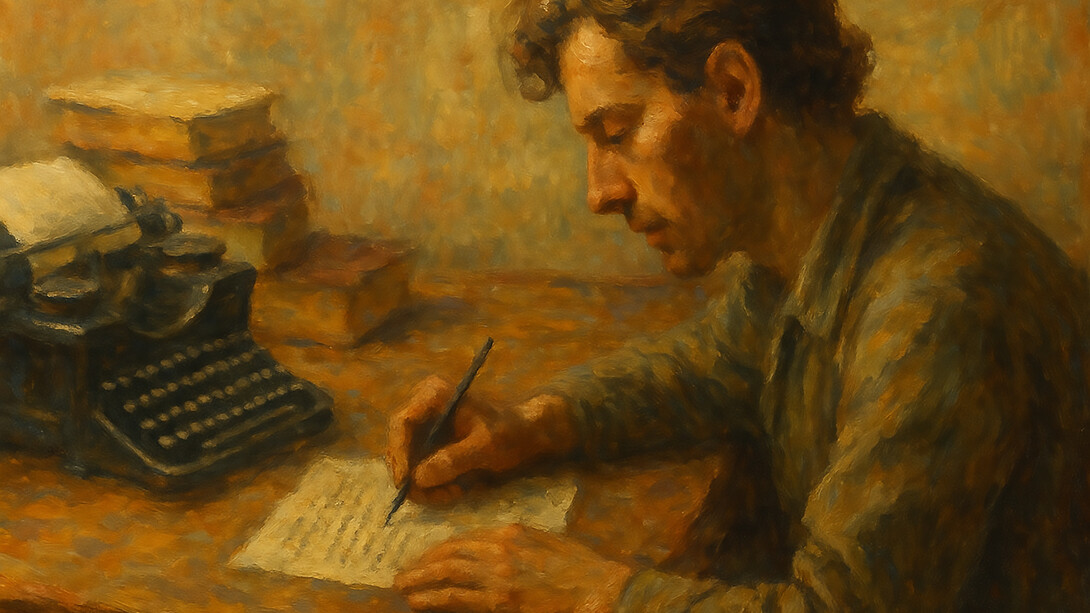There was a time—not long ago—when the texture of thought was measured in tactile resistance:
In ink-drag, in graphite dust,
In the angled tension of wrist against paper.
And later, in the staccato tempo of typewriter keys—
Their metallic resonance mimicking decisiveness,
Turning thinking into rhythm,
Fragments into paragraphs,
Effort into form.
Those were the decades when people believed
That the authenticity of writing
Was rooted in its motorics—
That truth emerged not from meaning,
But from friction.
Today, as artificial intelligence co-authors our drafts
Snd parses our prompts,
Some look back—longingly, stubbornly—
To the analogue rituals of "real writing."
They touch old pages,
They cherish imperfections,
They fetishize slowness.
But what they miss
Is not the past.
What they miss
Is orientation.
The Illusion of Motoric Authenticity
There is something strangely tragic
About the nostalgia for the haptic.
Not because it’s wrong—
But because it confuses form with source,
Tool with depth,
Expression with emergence.
To celebrate the scratch of ink
Or the thud of a key
Is to mistake the resonance
For the reason.
These were never anchors of truth.
Only acoustics around absence.
The machine, in retrospect, was never the medium of the soul.
It was an echo chamber for the conditions under which thought was permitted to surface.
And the myth of effort as authenticity concealed a deeper poverty:
The lack of structures for epistemic sovereignty.
We have long mistaken effort for depth,
And slowness for wisdom.
But without a coherent interior structure,
Even the slowest hand cannot escape repetition.
On Lazy Thinking and the Shadow of the Tool
Critics of AI often claim
That machine-written text
Is lifeless,
Mechanical,
Unearned.
But they forget:
Lazy thinking predates automation.
It does not begin with GPT.
It begins with epistemic dependence,
With the inability to ask
From where does this matter arise?
This crisis is not new.
It is only more visible.
AI reveals the redundancy we’ve long accepted—
That countless words are written
Not to mean something,
But to simulate participation.
Whether writing with pen or prompt,
Authenticity is not found in constraint—
But in the sovereign movement of thought
Through uncertainty,
Toward coherence.
The question is never how we write.
It is:
From what orientation does writing become real?
And yet, orientation is rarely taught.
Instead, we inherit modes of thinking as if they were muscles—
Practice repetition long enough, and you will become a thinker.
But without inner alignment, even the most fluent style
Becomes a performance of forgetting.
Sapiopoiesis and the Post-Motoric Writer
We are entering a new epistemic epoch—
Not because machines became smart,
But because the rituals of writing
No longer suffice
To hide our absence of sovereign thought.
Now, every act of articulation—
Whether handwritten or generated—
Demands an interior reckoning:
Is this expression
A performance of memory?
A citation of habit?
Or an emergence
From within a living architecture of sense?
To write in the infosomatic age
Is to no longer rely on rhythm or noise.
It is to stand still long enough
For meaning to gather—
In silence, in form, in risk.
This is the sapiopoietic turn.
Not writing as memory,
Not writing as performance,
But writing as orientation:
As sovereign synthesis of inner tension
And unclaimed possibility.
Such writing is not reactive.
It is architectural.
It builds slowly,
Like the growth of roots beneath language.
And it requires a new literacy:
A literacy of inner structures,
Of delays, contradictions, and epistemic traction.
Beyond Nostalgia: Toward Architectural Writing
Typewriters were never thinkers.
Neither are LLMs.
But neither were most human writers
When words were summoned to perform familiarity.
True writing is not mechanical.
Nor is it digital.
It is epistemic—
A gesture of interior cartography.
And perhaps this is what we are learning now,
In the age of ambient algorithms and artificial echoes:
That all we once revered—
The click, the scratch, the drag, the ink—
Were never the origin.
Only echoes around a caged meaning.
Now,
The cage is dissolving.
And with it,
The myth of authenticity
As surface.
The typewriter's rhythm
Was never the heartbeat of thought.
It was the pulse of a world
That confused tactility with truth.
What emerges now
Is not new technology,
But a new burden:
To write without excuse,
Without noise,
Without historical affectation.
The Silence Beneath the Sentence
In the end,
It is not the speed of the tool
Nor the slowness of the hand
That grants a sentence its force.
It is whether it knows
From which stillness it rose.
Silence is not absence.
It is potentiality unclaimed.
And true writing—today more than ever—
Requires that we return to that silence,
Not to fill it,
But to inhabit it.
The future of writing is not in resisting tools.
It is in refusing to abandon origin.















